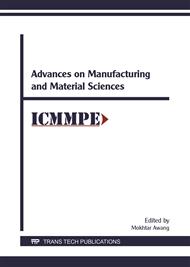[1]
M. Jimenez, S. Duquesne, and S. Bourbigot, Intumescent fire protective coating: Toward a better understanding of their mechanism of action, Thermochimica Acta, vol. 449, pp.16-26, 10/1/ (2006).
DOI: 10.1016/j.tca.2006.07.008
Google Scholar
[2]
F. Ahmad, S. Ullah, W. F. Mohammad, and M. F. Shariff, Thermal performance of alumina filler reinforced intumescent fire retardant coating for structural application, in IOP Conference Series: Materials Science and Engineering, 2014, p.012023.
DOI: 10.1088/1757-899x/60/1/012023
Google Scholar
[3]
W. F. Mohamad, F. Ahmad, and S. Ullah, Effect of inorganic fillers on thermal performance and char morphology of intumescent fire retardant coating, Asian J. Sci. Res, vol. 6, pp.263-271, (2013).
DOI: 10.3923/ajsr.2013.263.271
Google Scholar
[4]
S. Duquesne, S. Magnet, C. Jama, and R. Delobel, Intumescent paints: fire protective coatings for metallic substrates, Surface and Coatings Technology, vol. 180, pp.302-307, (2004).
DOI: 10.1016/j.surfcoat.2003.10.075
Google Scholar
[5]
S. Ullah and F. Ahmad, Effects of zirconium silicate reinforcement on expandable graphite based intumescent fire retardant coating, Polymer Degradation and Stability, vol. 103, pp.49-62, 5/ (2014).
DOI: 10.1016/j.polymdegradstab.2014.02.016
Google Scholar
[6]
S. Ullah, F. Ahmad, A. M. Shariff, and M. A. Bustam, Synergistic effects of kaolin clay on intumescent fire retardant coating composition for fire protection of structural steel substrate, Polymer Degradation and Stability, vol. 110, pp.91-103, 12/ (2014).
DOI: 10.1016/j.polymdegradstab.2014.08.017
Google Scholar
[7]
F. Ahmad, S. Ullah, and M. S. Hamizol, To Study the Effect of Aluminium Trihydrate and Fumed Silica on Intumescent Fire Retardant Coating, Journal of Applied Sciences, vol. 12, p.2631, (2012).
DOI: 10.3923/jas.2012.2631.2635
Google Scholar
[8]
J. H. Troitzsch, Overview of flame retardants, Chemistry today, vol. 16, (1998).
Google Scholar
[9]
K. S. Betts, New thinking on flame retardants, Environmental Health Perspectives, vol. 116, p. A210, (2008).
Google Scholar
[10]
S. Ullah, F. Ahmad, and P. Yusoff, Effect of boric acid and melamine on the intumescent fire‐retardant coating composition for the fire protection of structural steel substrates, Journal of Applied Polymer Science, vol. 128, pp.2983-2993, (2013).
DOI: 10.1002/app.38318
Google Scholar
[11]
S. Bourbigot, M. Le Bras, R. Leeuwendal, K. K. Shen, and D. Schubert, Recent advances in the use of zinc borates in flame retardancy of EVA, Polymer degradation and stability, vol. 64, pp.419-425, (1999).
DOI: 10.1016/s0141-3910(98)00130-x
Google Scholar
[12]
D. M. Schubert, F. Alam, M. Z. Visi, and C. B. Knobler, Structural characterization and chemistry of the industrially important zinc borate, Zn [B3O4 (OH) 3], Chemistry of materials, vol. 15, pp.866-871, (2003).
DOI: 10.1002/chin.200320010
Google Scholar
[13]
H. Li, Z. Hu, S. Zhang, X. Gu, H. Wang, P. Jiang, et al., Effects of titanium dioxide on the flammability and char formation of water-based coatings containing intumescent flame retardants, Progress in Organic Coatings, vol. 78, pp.318-324, 1/ (2015).
DOI: 10.1016/j.porgcoat.2014.08.003
Google Scholar
[14]
Z. Wang, E. Han, and W. Ke, Effect of acrylic polymer and nanocomposite with nano-SiO 2 on thermal degradation and fire resistance of APP–DPER–MEL coating, Polymer Degradation and Stability, vol. 91, pp.1937-1947, (2006).
DOI: 10.1016/j.polymdegradstab.2006.03.001
Google Scholar
[15]
E. ASTM, 119-05a Standard Test Methods for Fire Tests of Building Construction and Materials, ed: ASTM International. West Conshohocken. Pennsylvania, (2005).
Google Scholar
[16]
G. Wang and J. Yang, Influences of glass flakes on fire protection and water resistance of waterborne intumescent fire resistive coating for steel structure, Progress in Organic Coatings, vol. 70, pp.150-156, (2011).
DOI: 10.1016/j.porgcoat.2010.10.007
Google Scholar
[17]
C. Feng, Y. Zhang, D. Liang, S. Liu, Z. Chi, and J. Xu, Influence of zinc borate on the flame retardancy and thermal stability of intumescent flame retardant polypropylene composites, Journal of Analytical and Applied Pyrolysis, vol. 115, pp.224-232, 9/ (2015).
DOI: 10.1016/j.jaap.2015.07.019
Google Scholar
[18]
K. Apaydin, A. Laachachi, V. Ball, M. Jimenez, S. Bourbigot, and D. Ruch, Layer-by-layer deposition of a TiO2-filled intumescent coating and its effect on the flame retardancy of polyamide and polyester fabrics, Colloids and Surfaces A: Physicochemical and Engineering Aspects, vol. 469, pp.1-10, 3/20/ (2015).
DOI: 10.1016/j.colsurfa.2014.12.021
Google Scholar
[19]
R. G. Puri and A. S. Khanna, Effect of cenospheres on the char formation and fire protective performance of water-based intumescent coatings on structural steel, Progress in Organic Coatings, vol. 92, pp.8-15, 3/ (2016).
DOI: 10.1016/j.porgcoat.2015.11.016
Google Scholar
[20]
T. Orhan, N. A. Isitman, J. Hacaloglu, and C. Kaynak, Thermal degradation mechanisms of aluminium phosphinate, melamine polyphosphate and zinc borate in poly(methyl methacrylate), Polymer Degradation and Stability, vol. 96, pp.1780-1787, 10/ (2011).
DOI: 10.1016/j.polymdegradstab.2011.07.019
Google Scholar
[21]
Z. Wang, E. Han, and W. Ke, An investigation into fire protection and water resistance of intumescent nano-coatings, Surface and Coatings Technology, vol. 201, pp.1528-1535, 10/5/ (2006).
DOI: 10.1016/j.surfcoat.2006.02.021
Google Scholar
[22]
G. Wang and J. Yang, Influences of binder on fire protection and anticorrosion properties of intumescent fire resistive coating for steel structure, Surface and Coatings Technology, vol. 204, pp.1186-1192, 1/15/ (2010).
DOI: 10.1016/j.surfcoat.2009.10.040
Google Scholar


